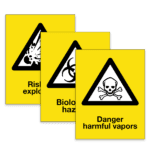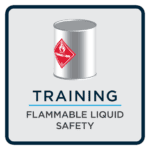An individual should always check the rules and regulations when working with flammable, dangerous goods. The Global Harmonization System (GHS) should be used when working with hazardous materials. When storing these hazardous goods, there are two main federal regulations to follow: The National Fire Codes of Canada (NFCC) and the Occupational Safety and Health Act (OSHA) in the United States. It is key to ensure the local province/state is consulted for any additional requirements.
Flammable storage cabinets are a very common sight in many workplaces, but an individual needs to be aware of the basic regulations when using these cabinets. First and foremost, there should always be a check-in with the manufacturer on the capacity that is allowed in the particular cabinet. Even though the regulations may allow a larger quantity stored together, the cabinet may have a specific requirement. Cabinet ratings can vary from 7.5L (2 gallons) to 340 L (90 gallons).
OSHA (United States)
- No more than 25 gallons of flammable liquids shall be stored in a room outside of an approved storage cabinet. However, if you want to store more than 25 gallons, you must do so in an approved flammable liquid storage cabinet: metal or wooden; see OSHA 1926.152(b)(2)(i) for wooden cabinet standards.
- Quantities of flammable liquid in excess of 25 gallons shall be stored in an approved cabinet meeting the following requirements:
- Maximum of 60 gallons is allowable of Category 1, 2, and/or 3 flammable liquids, or a maximum of 120 gallons of Category 4 shall be stored in any one storage cabinet.
OSHA category classification of flammable liquids vs. DOT Class 3 packaging Group’s (PG)
NFCC (Canada)
- The storage of flammable liquids and combustible liquids outside of a cabinet or storage room is permitted, provided you do not exceed
- 10 L, including not more than 5 L of NFCC, Class I, in a single room, or
- 250 L, including not more than 60 L of NFCC, Class II liquids, or 10 L of NFCC Class I liquids, in a single fire compartment with a fire-resistance rating of at least 45 min
- If you are storing more than these amounts, cabinets are required as long as the following are met:
- Flammable and combustible liquids less than 500 L (of which no more than 250 L can be Class 3 PG I) may be stored in a single cabinet.
Similar for Canada and the United States:
- No more than three (3) cabinets are to be grouped together, and each group of three must be separated by at least 30 m from any group;
- Cabinets shall be labeled, “Flammable-Keep Away from Open Flames”;
- Flammable liquids shall not be stored in areas used for exits, stairways, or normally used for the safe passage of people; and
- Must not be in an area easily accessible to the public/customers.
This is a general overview of small amounts of flammable and combustible liquids in the workplace. My next blog will go over larger amounts of indoor storage for flammable, dangerous goods.
Stay up to date and sign up for our newsletter!
We have all the products, services and training you need to ensure your staff is properly trained and informed.
 OSHA / WHMIS / GHS Training Courses |
 Custom or Stock Signs |
 Flammable Liquid Safety Webinar |









 ICC USA
ICC USA ICC Canada
ICC Canada